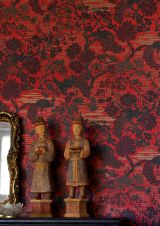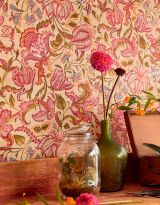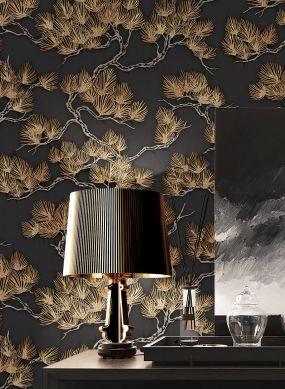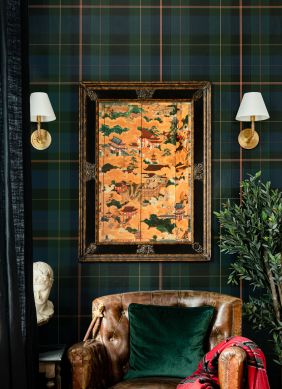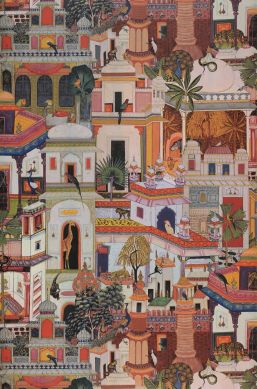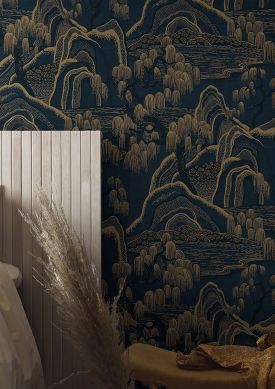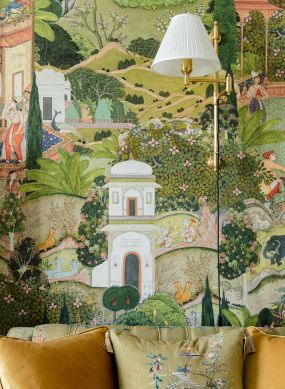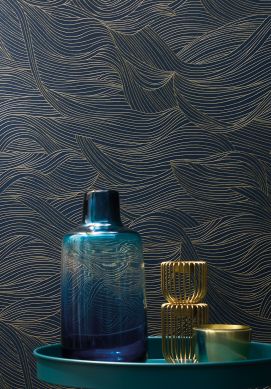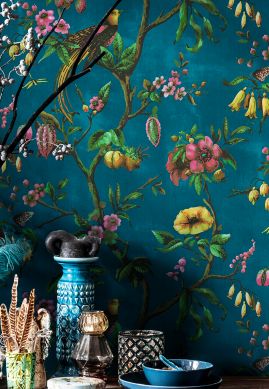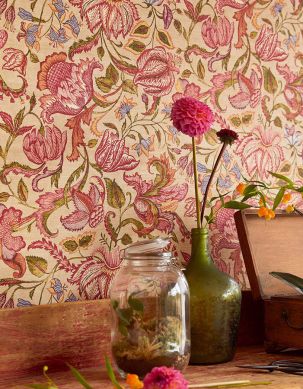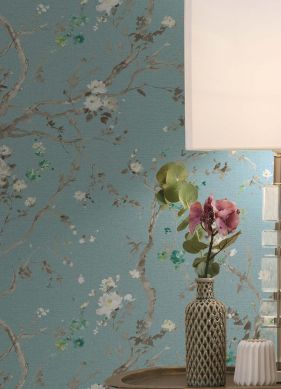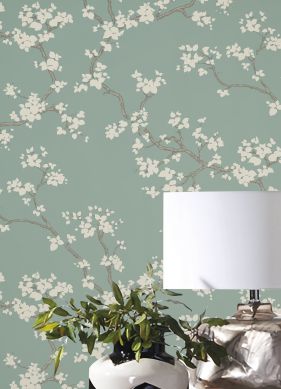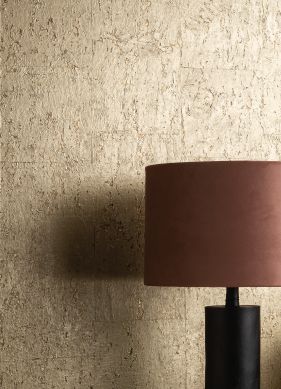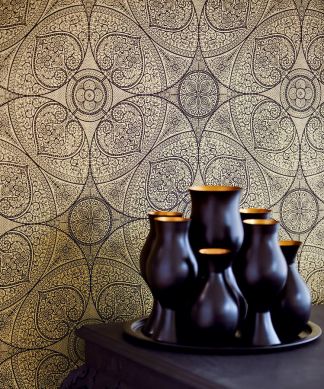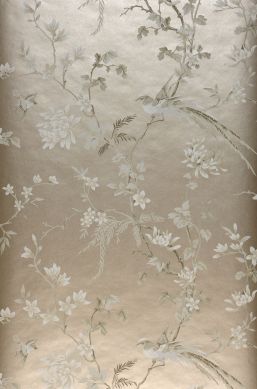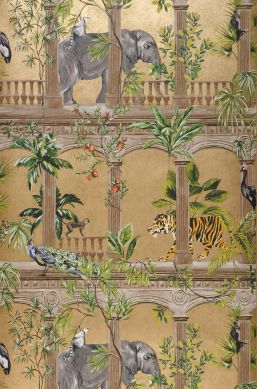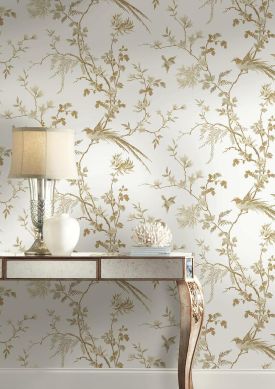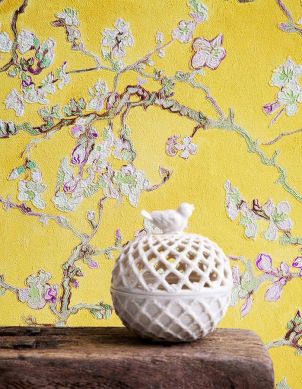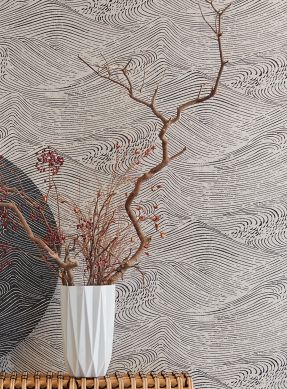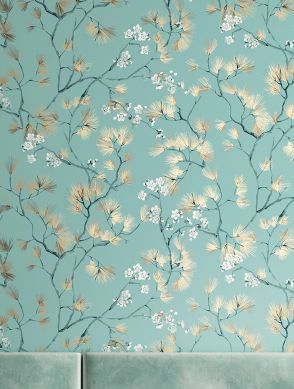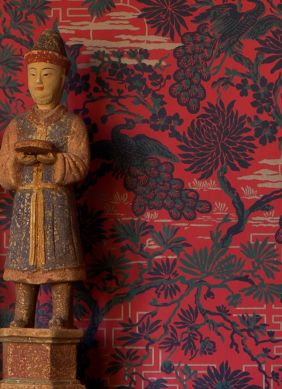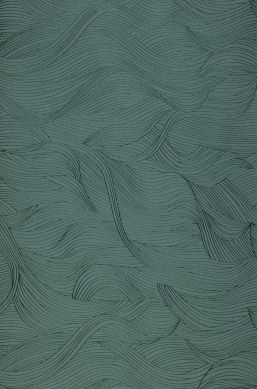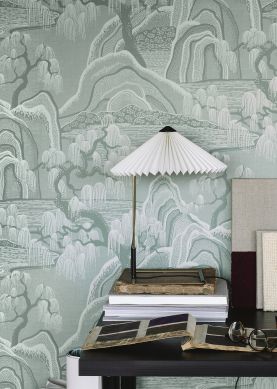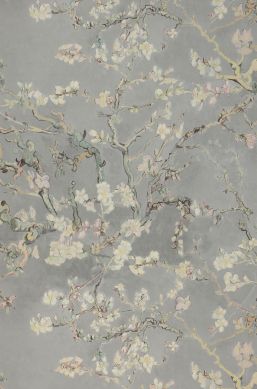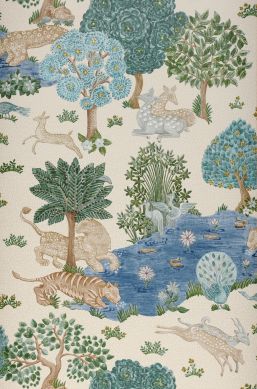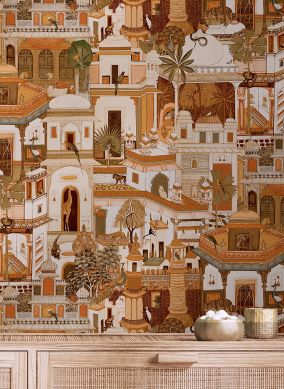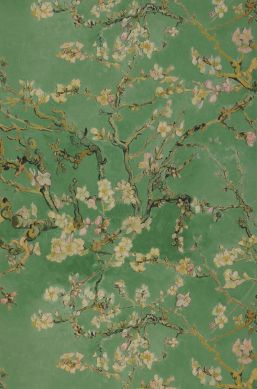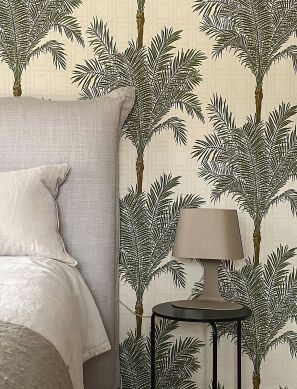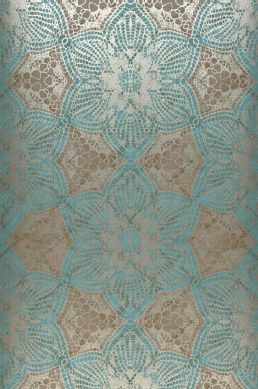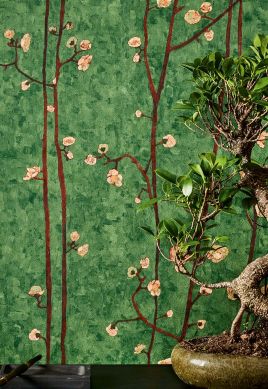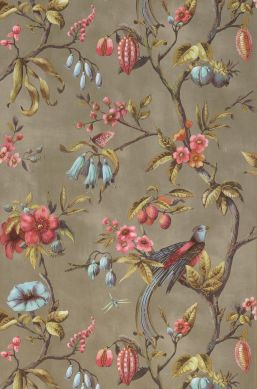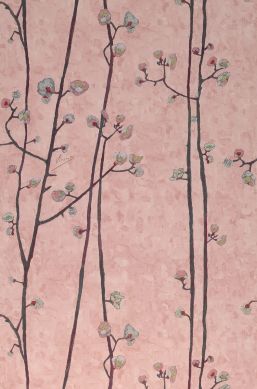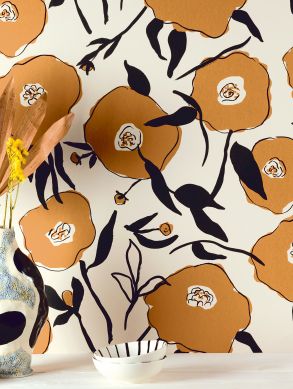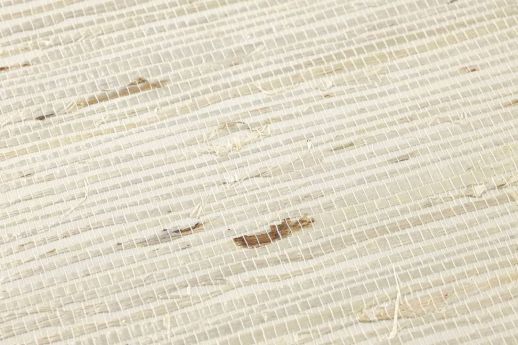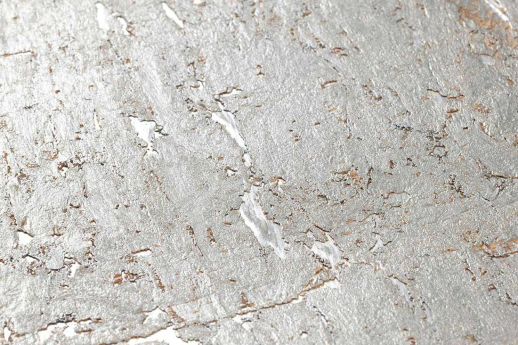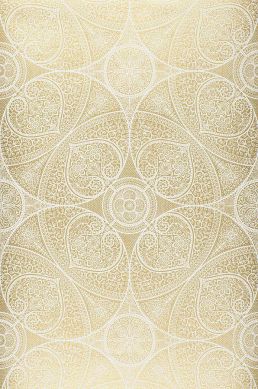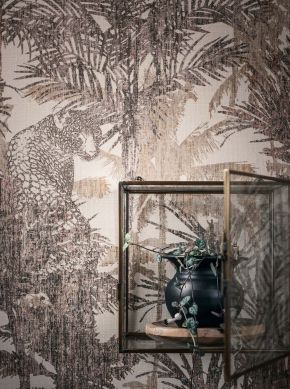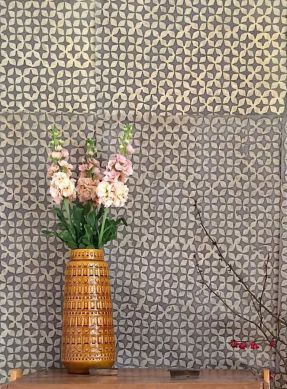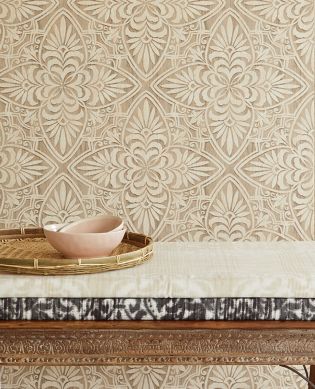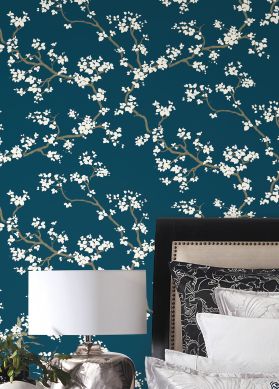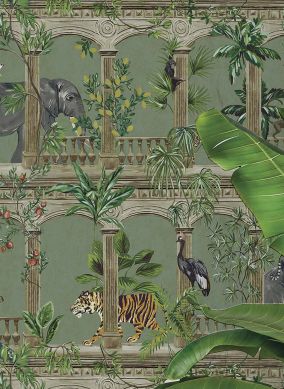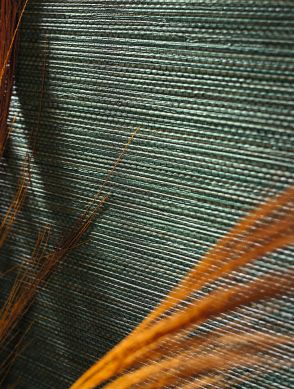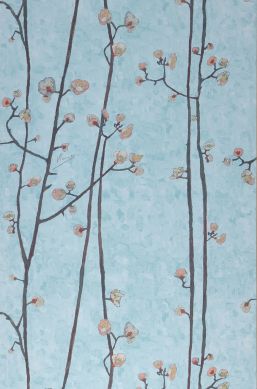Oriental Wallpaper
The exotic magic of the Orient for your walls! In our oriental treasure chest, you'll find wallpapers in the famous Chinoiserie style & rare Yoshino designs as well as patterns from "Arabian Nights".
Oriental Wallpaper: The Guide
Oriental wallpaper provides traditional and trendy Asian, Arab and North African pattern designs for fantastically exotic interior design concepts. The sought-after Chinoiserie from the 17th and 18th century comes back to life with magical motif wallpapers, too. This guide invites you to come along on an exciting journey to the fascinating Orient, as wallpaper models in the oriental style come in many different facets. In addition to a wealth of interesting information, you will also find ideas straight out of "Arabian Nights" for individual projects.
Contents
- Which countries and regions do oriental wallpaper motifs originate from?
- What are the most popular colours for oriental wallpaper?
- What are the most popular Asian wallpaper patterns?
- What are the most popular Arabic wallpaper patterns?
- What are the most popular wallpaper patterns from Northern Africa?
- What is "Chinoiserie"?
- What does ZEN mean in terms of Japanese interior design?
- Which rooms are particularly suitable for luxurious oriental wallpaper?
- Our tips: Ideas from Arabian Nights
Which countries and regions do oriental wallpaper motifs originate from?
The Romans defined the Orient as one of the four regions of the world that lies to the East. Today's oriental wallpaper patterns are mainly inspired by art, tradition and culture from Japan, China, India, Arabia and North Africa.
Japan
With more than 6,800 islands along the Pacific coast, Japan is the fourth largest island state in the world. The "land of the rising sun" is known for its breathtaking cherry blossoms, golden Buddhist temples, unique ZEN gardens and graceful geishas. The Japanese traditionally have a close relationship with paper, as the art of folding Origami and handmade "Washi" prove.
China
The regions of Tibet and the Gobi Desert, which were first mentioned in holy scriptures, are just as inseparably linked to China as the world-famous Silk Road or the gigantic pagoda temples. The East Asian People's Republic is the fourth largest country in the world. Folk art is still celebrated here, including calligraphy, silk painting and lantern making.
India
India is incredibly varied and colourful. The seventh-largest country on earth boasts a huge number of world-famous sights, including the Himalayas, the Red Fort in Delhi or the Taj Mahal. The cultural image of the Indian Mughal Empire is shaped by Maharajas, magical temple palaces, wild animals, Hindu culture and - last but not least - tapestry and rug art, which also inspire wallpaper designs.
Arabia
"Arabia" is primarily a term determined by Islamic culture. Geographically it includes the North African states on the Atlantic and Mediterranean coasts (e.g. Morocco, Tunisia), the Nile states Egypt and Sudan, the states on the Horn of Africa, the states on the shores of the Arabian Sea (including Oman, UAE) and the states of the Levant in the eastern Mediterranean.
North Africa
North Africa represents the northern part of the continent. Its countries border the Mediterranean Sea to the north, the Sahara desert to the south, the Atlantic Ocean to the west and the Middle East to the east. North African countries include Algeria, Libya, Egypt, Morocco, Sudan, Tunisia and Western Sahara.
What are the most popular colours for oriental wallpaper?
Oriental wallpapers glitter, sparkle and shine in vibrant spice colours or with bright, imaginative shades from Arabian Nights. Amongst the highlights of the colour range are gold, silver, red, blue, green, turquoise and black.
Gold
The Egyptians buried their dead with treasures of pure gold in vast quantities. Advanced civilizations hid mystical gold treasures in even more mysterious places and on islands. Gold is the symbol of the sun as well as power, fame and splendour. Consequently, many oriental fairy tales are also about gold. This radiant colour is the luxurious crown of oriental wallpapers.
Silver
In addition to gold, silver mines in the Orient and the Arab world are of great significance, especially in terms of history. This pure, cool colour with its typical iridescent shine is the perfect partner for gold and gives colours an enchanting magic. Modern oriental designs also benefit from this elegant soft hue which is often mixed with precious stone colours.
Red
Red is like fire for the senses and stands for passion that makes the blood pulsate. Pomegranate red is a favourite among the colours for oriental patterned wallpapers because it symbolises fertility, life, power and immortality. But darker, stronger shades of red such as crimson, Bordeaux and ruby are also extremely popular.
Blue
In the oriental colour world, blue carries many associations. First and foremost, it stands for the sea and the wide sky, but oriental rug and porcelain art is also linked to many shades of blue. Azure blue, navy blue, Persian blue and aquamarine are among the colour favourites for oriental pattern wallpapers. In addition, blue is relaxing and promotes concentration.
Green
The colour green generally stands for flourishing life. The ancient Egyptians thanked the Nile for making the landscape green and depicted the ancient Egyptian sky goddess as a green tree. In the Arab world, green is also associated with precious stones such as emerald and malachite, which are used as medical remedies. Blue-green is also often found in oriental designs.
Turquoise
In Arabia, gemstones, including turquoise, are highly valued. Many oriental tile patterns, ornaments and rugs are designed in the invigorating colour of the sea, which is both stimulating and calming. In combination with gold, a luxurious look is guaranteed.
Black
Black is the colour of Asian ink or charcoal drawings and calligraphy, but Indian Mehndis (skin paintings) are also often black or brown. Black is ideal for the pattern contours of oriental wallpaper designs. It has a magical and unfathomable effect. As a result, the colour also reflects mythology.
What are the most popular Asian wallpaper patterns?
The Asia-influenced pattern world draws inspiration from flora and fauna, traditional craftsmanship and mythology. Among the most beautiful motifs for its authentic spirit are cherry blossoms, dragons, lanterns, Chinese and Japanese characters or mandalas.
Cherry Blossom
The Japanese Yoshino mountain region is famous for its fascinatingly colourful and lush cherry blossom. This is why cherry blossom patterns are often referred to as "Yoshino" designs. Apart from cherry blossoms, magnolias and chrysanthemums also bloom on popular Asian pattern wallpapers. They all have one in common: a captivating romantic charm.
Bamboo
Bamboo wood and bamboo grasses are among the most typical Asian pattern motifs. On the one hand, they represent an important raw material, on the other hand a piece of Asian tradition and nature. In addition, leaves, branches and Asian trees such as the Himalayan cedar or the Cashmere cypress contribute to the atmospheric designs. Far Eastern bonsai plants can also be found on wallpapers.
Charcoal drawings
The Chinese art of painting is very diverse and artistic charcoal drawings are often combined with expressive watercolours. The works depict animals, landscapes, temples, flowers or events from history or fiction. They always tell a little story, even if they only consist of a few brush-strokes.
Carp
Historically, China is the oldest fish farming country and carp is an important part of Chinese cuisine. The carp also symbolises power and advantage. A pond full of carp means wealth and success, especially when it comes to Koi carp, which are among the most expensive, beautiful and iridescent carp species in the world.
Cranes & Herons
Cranes and herons are widespread in Asia and therefore a common motif for Asia-inspired wallpapers. These large proud birds awaken the longing for freedom and exude a soothing calm. In Japan, the crane is considered to be the bird of happiness. Birds are generally a popular Asian pattern motif.
Dragons
In Japan and China, dragons are mythical creatures as well as symbols of imperial rule and a long life. They also play an important role in folkloristic art. Their visual representation varies from country to country, which is why Asian-style wallpaper motifs are equally varied.
Lanterns
As a handicraft, the making of artistic paper and fabric lanterns is an ancient tradition in China. Today, these lanterns are popular interior design components all over the world. These sources of light are used for festive occasions and come in a plethora of beautiful shapes and designs. Red lanterns are regarded as lucky charms in China.
Landscapes
With their high mountains, imposing waterfalls, endless rivers and other bodies of water, flowering terraced fields and greenery as far as the eye can see, Asian landscapes are an unforgettable sight. Houses, temples, people and animals are lovingly integrated into these landscape motives. Landscape painting is part of folk art in China, among other countries.
Chinese and Japanese characters
Individual characters (Chinese, Japanese) or sentences and smaller texts are depicted in the form of calligraphy. Calligraphy is the art of writing by hand, e.g. with ink pen or brush, which gives letters an individual, elegant form. On wallpaper, characters are often combined with other Asian motifs.
Mandala, Henna & Mehndi
In Hinduism and Buddhism, Mandalas carry religious meaning. They stand for the holy circle or holy geometry which focuses on the energy in the centre. Henna and Mehndi are part of the Indian traditions of ornamental body painting with plant colours. These particularly delicate pattern motifs are a symbol of the Orient.
Straw wallpaper
Natural materials are part and parcel of interior and exterior design in Asia. Straw mats and straw papers are at the top of the list for floor and wall coverings. Real grass wallpapers and wallpapers with sisal, raffia or coconut fibres are used for beautiful natural wall coverings. Natural wallpapers are indispensable for ZEN and Feng Shui-style interior design concepts.
What are the most popular Arabic wallpaper patterns?
Princess Scheherazade, Captain Sindbad, the Caliph of Baghdad - Arabic pattern motifs visualise the stories of the famous "Arabian Nights". They show - to name but a few examples - oriental gardens, frescoes, Persian carpet patterns or elements of Arabic architecture.
Oriental flowers & gardens
Like a fairy-tale paradise with lush exotic flowers, palm trees, fountains and oases of peace: Oriental gardens take you to a dreamlike world of silence and beauty. Individual flowers like the oriental poppy or the oriental lily or gorgeous roses exude their magic via Arabic-style wallpaper models.
Ornaments & Frescoes
Frescoes, reliefs and ornaments inspired by the late antiquity of the Orient are essential elements of Islamic art & architecture. As a result, they are often used as pattern motifs for luxurious design wallpapers.
Arabesques
Branches and leaves that appear to be moving create stylised tendril ornaments which are called arabesques. Arabesques are among the most important means of expression in Islamic art, as is the symmetry that the patterns follow.
Persian tapestry patterns
The patterns of Persian tapestries are passed on from generation to generation, continually modified and refined, so that each piece is unique. Floral and geometrical elements create a wonderful unity, and bright colours add to the extraordinary charisma.
Geometrical mosaics
Geometric mosaics, e.g. Girih tiles, are constructed in a complex and elaborate way. They correspond to the geometric patterns in Arabic art which consist of circular or square sections. These are arranged in the manner of mathematical parquetry and continue indefinitely.
Arabic architecture
Arabic architecture is characterised by well-known features of Islamic architecture and Moorish art. Graphic and geometric wallpaper patterns based on Arabic architecture include these special features, e.g. arches, barrel vaults, Muquarnas, domes and columnar arcades.
What are the most popular wallpaper patterns from Northern Africa?
The patterns and motifs are as colourful and varied as the countries and regions of North Africa. Trellis, Moroccan tiles, Egyptian arts and crafts, oriental palaces, Sahara rock paintings and African culture serve as models for wallpaper designs.
Trellis Patterns
Virtually everyone knows the Moroccan trellis pattern, and yet there is no word in any other language to describe it accurately. This traditional pattern motif consists of a kind of geometric lattice composed of circular or diamond shapes.
Moroccan tile and tile motifs
Incredibly colourful depictions of small-scale Arabic geometric mosaics, ornaments of Islamic art and sometimes flowers or ship motifs - Moroccan tiles, including the Azujelos (which the Moors introduced to Spain) fill the room with a fabulous holiday feeling.
Egyptian arts and crafts
Orientalism is frequently represented by typical objects, especially from Egyptian arts and crafts. Busts and sculptures of deities and Pharaohs as well as hand-painted papyrus, handmade mother-of-pearl boxes, jewellery, precious jugs and vases are among the pattern motifs that inspire oriental wallpapers.
Oriental Palaces
This is where the fairy-tales and adventures of Arabian Nights take place. Oriental palaces captivate the visitor with their architectural form, the splendour of gold, mosaics, bright colours. On wallpaper, these motifs can be silhouette-like, delicate drawings or modern 3D-prints.
Rock paintings in the Sahara
The Sahara desert is home to mankind's oldest rock paintings, some of which are up to 14,000 years old and have astonished researchers since time immemorial. One of them is Ladislaus Almásy who in 1933 discovered the Egyptian Cave of Swimmers with rock paintings of floating figures. The legendary movie "The English Patient" (1996) is based on his story.
African culture
African culture is characterised by many different ethnic tribes with their traditional dances, musical instruments and songs. Masks, ethno patterns, body painting, clothing and special jewellery make up the African look and transport the beholder into an exotic and mysterious world.
What is "Chinoiserie"?
Chinoiserie is a European art movement based on Chinese and Japanese models which was very fashionable in the 17th and 18th century. Porcelain, lacquer, silk, as well as Chinese paper and silk wallpapers are the main elements of this decorative design era.
European art movement
Europeans often had a somewhat romantic idea of countries such as China, Japan or India, thinking of them as exotic, peaceful gigantic kingdoms. Coupled with their enthusiasm for the respective arts and crafts of those mysterious lands, this led to the blossoming of Chinoiserie as an independent art form between 1650 and 1820. It is divided into imitative, freely imagined and romanticising Chinoiserie.
Chinese and Japanese models
In Chinoiserie, everything that is known about China and Japan and considered typical by Europeans can become a pattern motif. Some examples are pagodas, pavilions, Asian flower patterns, historical representations of people and landscape scenes. In addition, there are whimsical exotic fantasies, some of which appear bizarre, humorous and like sympathetic caricatures.
Inspired by porcelain, lacquer or silk
Chinese arts and crafts are predominantly characterised by porcelain, lacquer and silk. Chinoiserie is usually a mix of genuine originals and European arts. Copying originals, including hand-painted porcelain, lacquer work and silk painting, is another feature of Chinoiserie, which is given a new perspective by European influences.
Chinese paper and silk wallpapers
In China, silk wallpapers were produced as early as the Han dynasty (206 B.D. - 220 A.D.) as embroidered lengths of silk. From the 4th century onwards, paper wallpapers (bamboo/linen) were hand-painted with Far Eastern motifs. In the 16th century, Chinese wallpapers were introduced to the European market. This was the beginning of Chinoiserie wallpaper production in Europe.
What does ZEN mean in terms of Japanese interior design?
ZEN Buddhism is based on meditation and mindfulness, elements that are also reflected in Japanese interior design. These are the maxims: concentrating on the essential, calm and order in the immediate surroundings, simple organic wallpaper patterns with subtle colours.
Concentrating on the essentials
ZEN rooms are reduced to the bare essentials, with minimalistic furniture. Anything that is superfluous or challenges or even burdens the mind is avoided. Even pieces of furniture that are not in constant use are left out. The ideas are clear, the mind can focus on the inside and perceive the interior and exterior world with the inner eye.
Calm and order in your own four walls
A sense of visual order facilitates relaxation and forms the basis for internal order. The overall design should exude calm and instil a sense of harmony. Opulence, chaos and exuberant luxury hinder meditative thoughts. Design and nature forge a connection. In terms of decorative elements, a handful of carefully selected plants is sufficient.
Simple, organic wallpaper patterns and subtle colours
Natural wallpaper materials like grass, bamboo, linen and organic patterns inspire the ZEN philosophy. Subtle and neutral colours are preferable to bright or gaudy hues. White, grey, beige or sand are all popular wallpaper colours for the ZEN style.
Which rooms are particularly suitable for luxurious oriental wallpaper?
The specific orientation towards Asian, Arabic or North African styles determines the choice of room. Rooms that are particularly suitable for oriental styling ideas are bedrooms, dressing rooms, living rooms and bathrooms.
Bedroom
Exotic secrets, the magic of the unknown, fairy-tale luxury - oriental wallpapers introduce these aspects into the room and promise beautiful dreams. Shimmering trellis patterns, Arabic ornaments with glittering gold elements and intense darker colours transform the bedroom into an oasis of peace straight out of Arabian Nights.
Dressing room
Oriental wallpapers with Asian, Arabic or North African motifs stimulate the imagination, which also happens to be a significant element of fashion. Their individual beauty also creates a connection to the dressing room, which inspires fashion choices. Chinoiserie wallpaper models are perfect for elegant dressing room designs.
Living room
The living room is a great canvas for just about any desired theme. Saharan safari, Marrakesh lounge, enchanting Chinoiserie or romantic cherry blossom designs - the choice is yours! In addition to matching oriental wallpaper patterns, authentic decorative elements play an important role in the implementation of Orient-style interior design concepts.
Bathroom
The bathroom offers plenty of potential for the use of oriental wallpapers. In addition to very puristic ZEN designs, this room can be transformed into an Egyptian spa or a luxurious hammam.
Our tips: Ideas from "Arabian Nights"
- Aladdin's wonderland in children's rooms: A feature wall decorated with an Arabic ornamental wallpaper in strong fairy-tale colours and gold creates an Orient Palace for the great stories from Arabian Nights. As accessories, the flying carpet and the magical wonder-lamp should not be missing.
- The spa of Egyptian gods: Papyrus-like wallpaper with Egyptian gods such as Hathor, Isis, Horus, or ancient Egyptian art motifs transform the bathroom into a spa worthy of Nefertiti and Cleopatra. Opt for golden bathroom accessories, vases and flacons in the style of ancient Egypt.
- Out of Africa - a mix of ethnic and animal fur patterns: Wallpaper models with African wooden masks or ethnic patterns create an exotic feature wall in the living room. A matching animal fur wallpaper (leopard, zebra) is used to decorate a piece of furniture, e.g. a shelf, chest of drawers or plant column. This creates a harmonious contrast that emphasises the exoticism of the overall design.
- Marrakesh lounge: Moroccan tile patterns, e.g. Trellis, in maritime or intense colours such as turquoise, violet and orange and preferably with shimmering details, can cover all living room walls or just one feature wall. Floor cushions and a generous seating area, oriental green plants and floor lamps add to the charm of the room.


